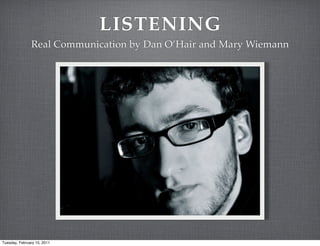
Listening
- 1. LISTENING Real Communication by Dan O’Hair and Mary Wiemann Tuesday, February 15, 2011
- 2. HEARING Physiological process of perceiving sound using sound waves. Tuesday, February 15, 2011
- 3. LISTENING The process of recognizing, understanding, and accurately interpreting messages from others. Tuesday, February 15, 2011
- 4. THE PROCESS Listening seems automatic but it involves a complex web of skills. Tuesday, February 15, 2011
- 5. THE PROCESS selecting one sound over others attending or focusing understanding is interpreting and making sense of the message Tuesday, February 15, 2011
- 6. THE PROCESS remembering or recalling information responding to get feedback active listeners and passive listeners Tuesday, February 15, 2011
- 7. STYLES OF LISTENING people-oriented They listen with relationship in mind and are concerned about other’s feelings. Tuesday, February 15, 2011
- 8. STYLES OF LISTENING action-oriented They are focused on tasks. Tuesday, February 15, 2011
- 9. STYLES OF LISTENING content-oriented They are critical listeners who evaluate what they hear. Tuesday, February 15, 2011
- 10. STYLES OF LISTENING time-oriented They are most concerned about efficiency. Tuesday, February 15, 2011
- 11. REASONS FOR LISTENING Informational Listening is when we need to understand the message. We may ask questions to be able to understand and we are interested in listening. Tuesday, February 15, 2011
- 12. REASONS FOR LISTENING Critical Listening is used to evaluate and analyze the message for accuracy. We want to determine the main point, to concentrate, to pay attention to nonverbal cues, and to remember the message. Tuesday, February 15, 2011
- 13. REASONS FOR LISTENING Empathic Listening is attempting to know how the other person feels while providing emotional support. Paraphrasing the speaker’s thoughts and feelings will legitimize us. Tuesday, February 15, 2011
- 14. REASONS FOR LISTENING Appreciative Listening seeks to receive pleasure from the sounds. This can relieve stress, clear the mind, and refresh the soul. Listening to music or background sounds can do this. Tuesday, February 15, 2011
- 15. BENEFITS OF LISTENING 1. help your career 2. save your company 3. save time and money 4. create opportunities 5. strengthen new and existing relationships Tuesday, February 15, 2011
- 16. LISTENING BARRIERS Environment Hearing impairments Multitasking Boring speaker Our attitudes Tuesday, February 15, 2011
- 17. LISTENING BARRIERS Listening apprehension is a state of fear or anxiety associated with listening opportunity. They find it hard to concentrate on a message or even remember what was said. Tuesday, February 15, 2011
- 18. LISTENING BARRIERS Unethical behaviors defensive selective monopolistic or selfish listeners insensitive or hurtful pseudo-listening Tuesday, February 15, 2011
- 19. DIFFERING CONTEXTS Physical context is when you are uncomfortable with your surroundings. Tuesday, February 15, 2011
- 20. DIFFERING CONTEXTS Relational context influences how you listen. Tuesday, February 15, 2011
- 21. DIFFERING CONTEXTS Listening traits are culturally influenced. Japan and China are more listener-responsible, while US is more speaker- responsible. Tuesday, February 15, 2011
- 22. DIFFERING CONTEXTS Technology can make it more difficult to decode a message without the help of nonverbal communication. Tuesday, February 15, 2011
